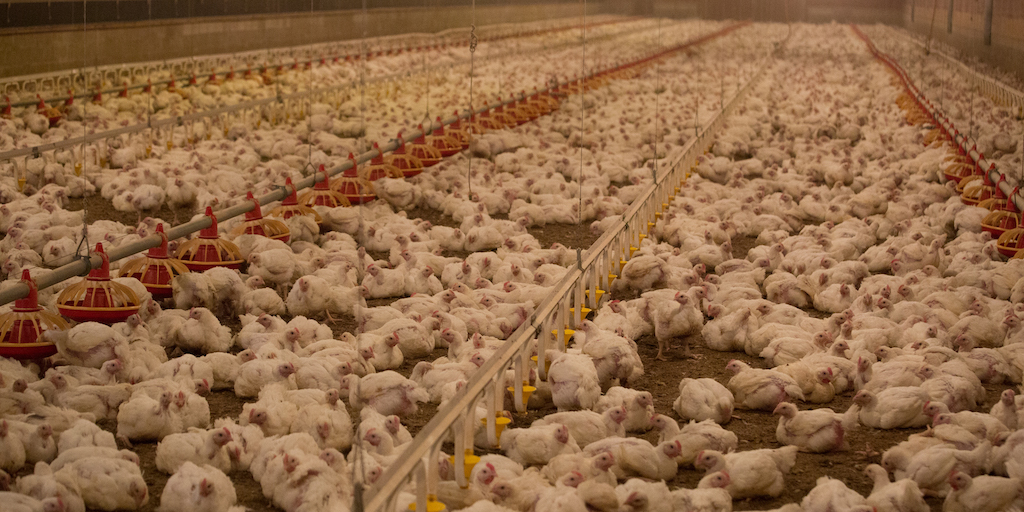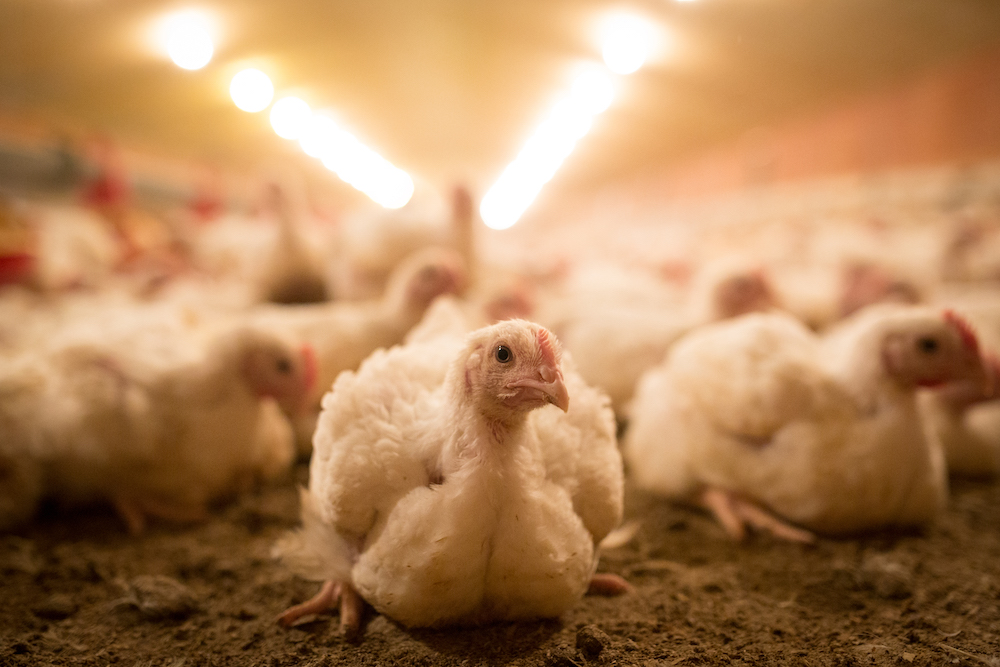
Bird flu: An animal welfare and biosecurity disaster
July 9th, 2024The spread of bird flu, which has led to the killing of tens of millions of farmed birds globally, prompts us to examine the role of intensive animal farming in zoonotic disease outbreaks, and rethink our entire relationship with animals.
What is bird flu?
Bird flu is a contagious disease caused by avian influenza viruses that can affect all types of birds and sometimes spread to other animals, including humans. Highly pathogenic strains have been circling the globe causing outbreaks, periodically, for decades. These strains can cause serious illness and death to infected animals. Symptoms include weakness, tremors, difficulty breathing, lack of co-ordination, diarrhoea, blindness, and paralysis.
Bird flu thrives in intensive farming conditions
Overcrowded and filthy conditions on farms, including in free range systems, create optimal environments for bird flu to spread rapidly between thousands of birds. When confined to intensive farming conditions, birds are unable to escape the disease once it enters the flock. The genetic similarity of all the birds, combined with their weakened immune systems due to high levels of stress, make them even more susceptible. Farming animals in these conditions also increases the likelihood that bird flu will spread to humans.
Bird flu leads to mass killing of birds
Gruesome mass killings are carried out every time there’s an outbreak on farms, and tens of thousands of birds are killed in an attempt to stop the spread of the disease. They may be gassed to death or suffocated using foam. Turkeys, ducks, and geese may be killed using captive bolt guns.
When we think of the fear and pain a single bird must experience when killed, it’s difficult to comprehend the scale of suffering endured by these gentle animals. Disturbingly, mass killings are not carried out to prevent more birds from suffering from the disease, but to minimise the economic loss that would occur if more birds were infected.

Bird flu is only the tip of the iceberg
The mass killing associated with bird flu exemplifies the inherent cruelty of intensive animal agriculture. Mass killing is an integral feature of farming birds and is already taking place every day in Aotearoa to produce eggs and chicken meat. In the egg industry, all hens are killed when they are only 18 months old as their egg production declines, and chickens bred for meat are all killed at approximately 6 weeks old, while they are still babies.
Further, infectious diseases are already prevalent on intensive bird farms. These include salmonella and campylobacter – the most common cause of foodborne illness in Aotearoa which has earned us a reputation as “campylobacter capital” of the world.
Rethinking our farming of animals
The threat bird flu poses to farmed birds and to human health is drastically increased by our intensive farming practices. The recent surge in bird flu should serve as a wake-up call about the danger of intensive animal farming when it comes to zoonotic disease outbreaks.
The routine mass killing of farmed birds underscores the need for us to reevaluate our relationship with animals. Every day, sentient animals are systematically killed as mere units of production. We must alter the way we think about farmed animals, from viewing them as “food” or opportunities for economic gain, to recognising them as sentient individuals worthy of dignity and respect.

Eat with compassion
Make a true difference for farmed birds by boycotting the industry altogether. Check out our egg free and chicken free recipes or sign up to our plant based challenge.
Bird flu FAQs
Is bird flu in Aotearoa?
In December 2024, the first highly pathogenic strain of bird flu was discovered on a chicken farm in North Otago. Hens were infected with the H7N6 strain, likely through contact with wild waterfowls. Due to the intensive nature of chicken farming in Aotearoa, the virus quickly spread through other sheds on the farm and as a result, over 80,000 birds have been killed. The birds were herded into a confined area and killed by carbon dioxide poisoning – a method known to induce fear, air hunger (suffocation), anxiety, and pain.
Over 120 million chickens are intensively farmed every year in Aotearoa, and SAFE is deeply concerned that the death toll will continue to rise.
Can bird flu spread to humans?
Although not common, there have been cases where bird flu has spread to humans. Symptoms can be mild to serious, including breathing problems, fever, conjunctivitis, vomiting, and diarrhoea. Between 2003 and 2024 there have been 463 human deaths from the H5N1 strain (source). When bird flu does spread to humans it rarely continues to spread from person to person. The main concern around bird flu affecting humans is if bird flu viruses were to mutate into strains that do affect humans easily and spread from person to person, which could potentially lead to the next human pandemic (source).
Bird flu has recently spread to cows, which has also fuelled concerns about the potential for human infection.
Do indoor farming systems keep bird flu out?
No, bird flu can enter intensive indoor farms on contaminated shoes, clothing, bedding, feed, and equipment, and due to the vast number of birds confined in crowded and unsanitary conditions, the virus spreads quickly (source). Free range egg farms are also at risk of the outdoor areas being infected by wild birds, and since free range farms also contain thousands of birds in crowded and unsanitary conditions, they too create the ideal environment for the virus to spread rapidly between birds.
Are there different types of bird flu?
There are many distinct types of bird flu viruses, and they are classified as either low pathogenic avian influenza (LPAI) types or highly pathogenic avian influenza (HPAI) types. Most bird flu viruses are low pathogenic, and cause only few or no sign of disease in both wild and farmed birds. Highly pathogenic bird flu viruses can cause serious illness and high mortality to wild birds, and they affect farmed birds the most due to the conditions they are kept in (source).
Is bird flu a threat to our native species
It is unclear exactly what effect a strain of highly pathogenic bird flu would have on native species in Aotearoa. However, these strains can cause high numbers of deaths to wild birds, and based on what we have seen overseas, a highly pathogenic strain would be most likely to affect colony nesting seabirds in Aotearoa (source).
What is the history of bird flu?
Bird flu was first described in 1878 in Italy as a contagious disease among farmed birds (source), however bird flu viruses are considered as naturally occurring viruses among wild bird species worldwide. Wild aquatic birds are considered the reservoirs, or hosts, of bird flu viruses, from whom the disease then spreads to other bird species and animals. The first outbreak on bird farms in the United States was in the 1920s (source).
Which mammals has bird flu spread to?
Between 2020-2023, the current wave of the H5N1 bird flu virus was detected in 48 different species of mammals, affecting thousands of individual animals. Most species affected were terrestrial or semiaquatic, but 13 marine mammals were also impacted, resulting in a large number of deaths (for example, sea lions). Most mammal species infected were carnivores, including mountain lions, foxes, and even polar bears. It has been noted that the geographic area and the number of animals affected is considerably larger than in previous waves of infection (source).
